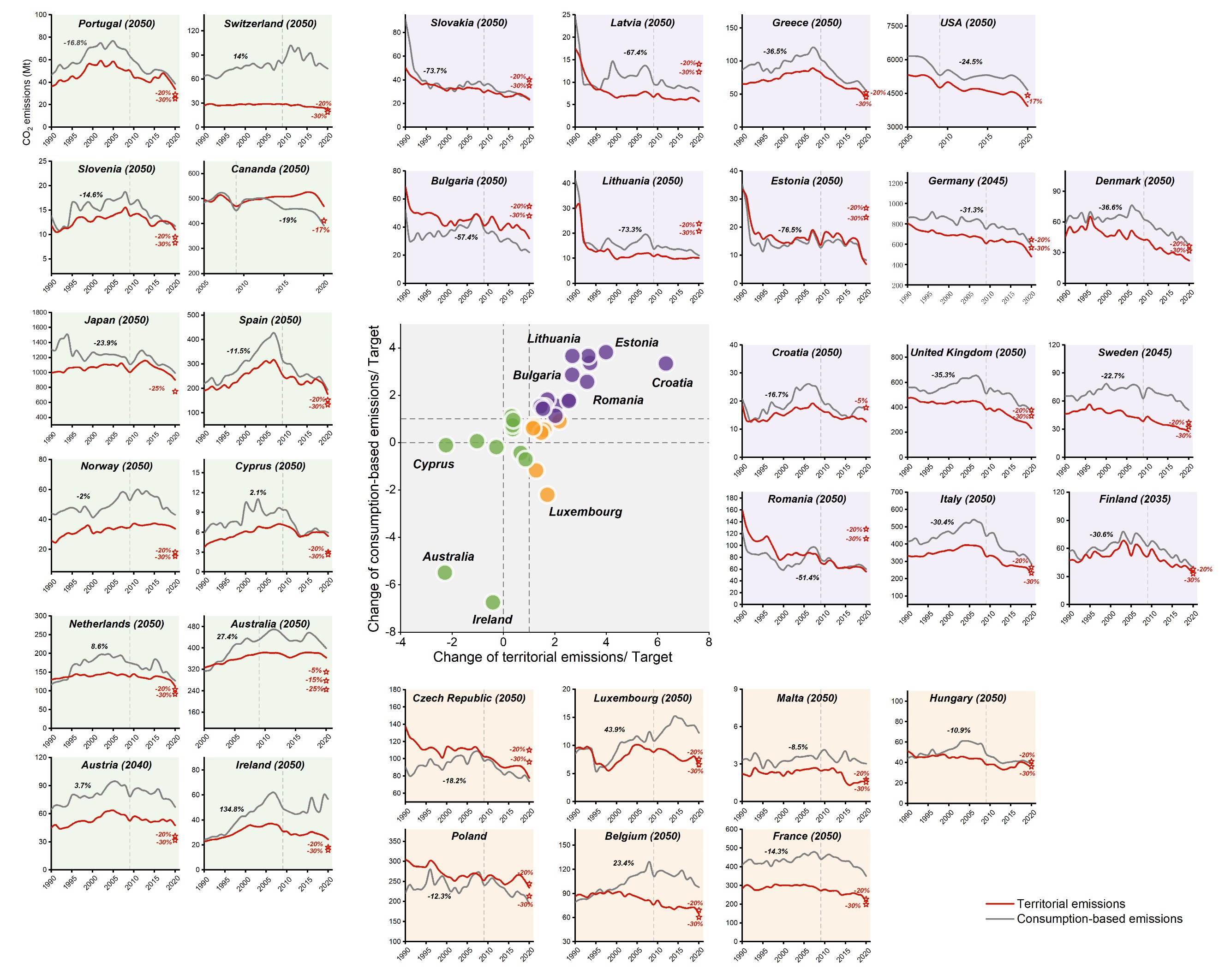Many economies set climate mitigation targets for 2020 at the 2009 15th Conference of the Parties conference of the United Nations Framework Convention on Climate Change in Copenhagen (COP15), which has become an important milestone in the global climate mitigation actions. How to track the completion of climate mitigation targets in countries around the world and analyze the climate mitigation paths and driving factors is of great significance for the global joint response to climate change challenges, effective formulation of future climate mitigation strategies and meeting the Paris Agreement targets.
Recently, on the basis of systematically revisiting climate mitigation targets of countries raised at COP15, Guan Dabo’s Research Group of the Department of Earth System Science (DESS), Tsinghua University, tracks the changes in territorial and consumption-based CO2 emissions with the method of input-output analysis, and reviews the completion of climate mitigation targets set by developed countries in the “Copenhagen Agreement”. The research, in the light of the LMDI decomposition method, explores the key socioeconomic factors affecting changes in mitigation, and evaluates countries challenges faced in economic growth and meeting climate mitigation targets. The research results offer scientific basis for countries to set reasonable and effective mitigation strategies and conducting targeted coordinated climate governance.
The research focuses on the gap between the actual emission modes and COP15 targets. At the Parties conference of the United Nations Framework Convention on Climate Change, countries’ climate mitigation targets were set based on territorial emissions. Environmental policy makers are increasingly concerned with the emission “outsourcing” called “carbon leaking” or “carbon transfer”. To address potential carbon leakage problems, this research, while analyzing territorial carbon emissions, also deeply explores consumption-based emissions. Among the 34 developed countries analyzed, 15 met their targets, 12 failed to meet their targets, and 7 achieved the target for territorial emissions, albeit with carbon leakage through international trade to meet domestic demand while increasing emissions in other countries.

Fig. 1 CO2 emission trends and emissions mitigation target range of COP15.
It has been discovered in the research that to achieve nationally determined contributions (NDCs) in 2030, 19 countries out of the 34 will have to cut more emissions in the next 10 years than they did from 2010 through 2020 (Fig. 4a). Thus, the shift in emissions levels in 2020–2030 must be greater than that in 2010–2020. In Norway, Croatia and Japan, for example, their economic growth rates of in 2010–2020 were 14.8%, 19.5% and 3.6%, and emissions in these countries dropped by 9.1%, 20.9% and 14.2%, respectively. Their economies will grow largely by 25.2%, 31.4% and 12.4%, respectively, whereas their emissions will need to fall by a further 61.8%, 34.2% and 30.7% to meet their NDCs for the next stage (2020–2030). Therefore, these countries must urgently improve energy intensity and adjust their energy mix to meet the dual pressure of climate mitigation and economic development.
The differences in climate mitigation target setting, energy utilization efficiency and energy structure setting among different countries lead to significant heterogeneity in climate mitigation effectiveness among countries. The present research deeply analyzes the situation of countries’ completion of Copenhagen climate mitigation targets, and reveals the underlying reasons for the differences in climate mitigation effects across different countries. The research demonstrates the importance of timely tracking the completion of climate mitigation targets by countries at different stages and provides a key reference for the formulation of future climate mitigation measures. In addition, it is critical to identify the potential carbon emissions leakage by accounting consumption-based carbon emissions for fairly and transparently evaluating the contribution of countries to climate mitigation, conducive to realizing comprehensive and accurate tracking of carbon emissions.
The related research results have recently been published in the form of a paper titled “Revisiting Copenhagen climate mitigation targets” in Nature Climate Change.
Li Shuping, doctoral student of the DESS, Tsinghua University is the first author of the paper, and Professor Meng Jing of University College London is the corresponding author. Collaborators include Professor Klaus Hubacek from the University of Groningen, the Netherlands, Professor Shaikh M. S. U. Eskander from the London School of Economics and Political Science, and Dr. Chen Peipei from University College London. This research is supported by National Key R&D Program of China, Tsinghua University International Joint Mission On Climate Change and Carbon Neutrality, National Natural Science Foundation of China and Horizon Europe.
Full-text link: https://www.nature.com/articles/s41558-024-01977-5